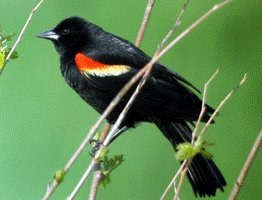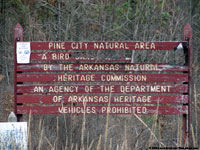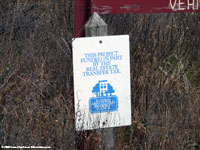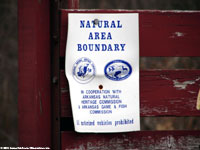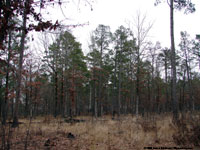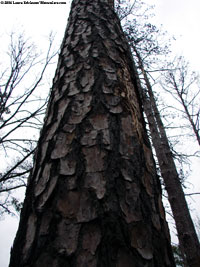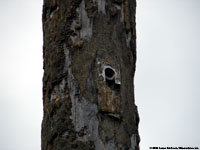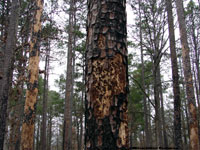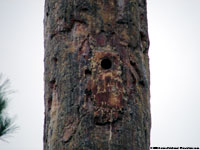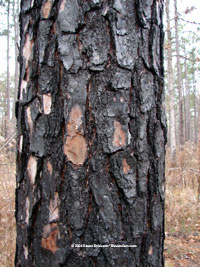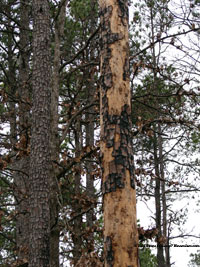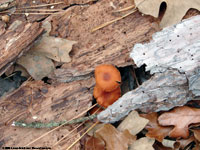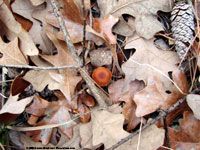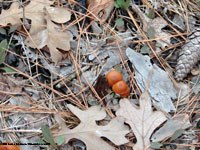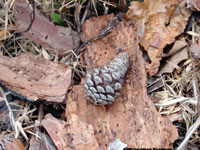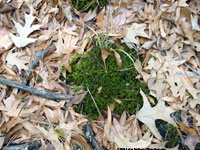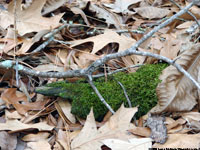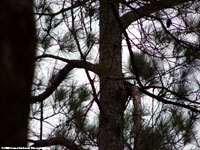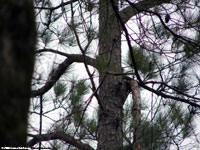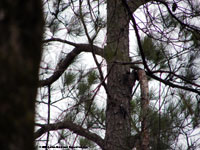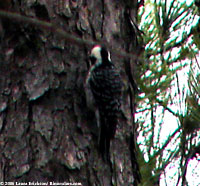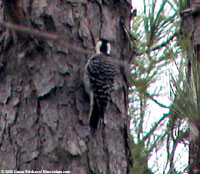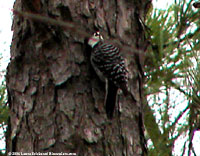|
Laura's Red-cockaded Woodpecker information This page has photos of our trip to Pine City on January 20, 2006, information about Red-cockaded Woodpeckers, and the script of my February 3, 2006 "For the Birds" program about the species. Information about Pine City and directions can be found at the Pine City Natural Area entry of the Arkansas Natural Heritage Commission website. Learn a lot about Red-cockaded Woodpeckers and see MUCH better photos at:
Red-cockaded Woodpeckers--"For the Birds" script for February 3, 2006 In April, 1999, my family went to Florida for spring break, and I saw my very first Red-cockaded Woodpecker. This endangered species nests and roosts in certain species of southern pine trees that ooze resin—apparently the sticky stuff keeps tree-climbing rat snakes out of the woodpeckers’ excavations. Because of the birds’ very specific habitat needs, they’ve been in trouble for a very long time-they’ve been on the Endangered Species List since 1968. Since then, researchers have put a great deal of effort into restoring this species, keeping it going in small pockets here and there despite the way so much habitat has been converted from Long-leaf Pine to Slash Pine. I saw my first birds at the Three Lakes Wildlife Management Area, not too far from Orlando. Russ and I had gotten up about 3:30 am and driven there to arrive before first light. The easiest way to see the birds is to find an active nest or roost hole and park yourself there before dawn, to watch the birds emerge as they awaken. Sure enough—when the sun popped up, out they came. We watched 2 or 3 birds emerge, feed in nearby trees for a while, and fly off. And that was that. Some observers to this in reverse—an hour or so before sunset they plant themselves near a cavity and watch for the birds to come in for the night. I haven’t tried that technique yet. Red-cockaded Woodpeckers range throughout the southeast, wherever they can find old growth southern pine forests for food and habitat. And there are a few places in Arkansas where they live, so while I was there, Paula, Photon and I headed to one of them—a sanctuary for them called Pine City Natural Area, managed by the Arkansas Natural Heritage Commission. They’ve constructed some cool nest boxes right into the trees near the entrance—you have to look carefully to realize these are artificial rather than natural cavities. Most birders wait here at the entrance to see the birds at first light or day’s end. But our little party arrived at mid-morning, so we actually had to look for the birds during their daytime routines. We heard a couple of their soft calls right off the bat, but from a distance, and it took us a good half hour or even 45 minutes to finally get good looks. Of course, that time lag was completely pleasurable, as we listened to some really cool Pine Warbler songs and enjoyed a bunch of other woodpeckers and other birds. And little by little, we pinpointed where the Red-cockaded Woodpeckers were feeding in their sociable little group, and finally came upon them. They’re in the same genus as Hairy and Downy Woodpeckers, but have big white cheek patches offset by a black nape, crown and throat. We saw at least five birds—possibly as many as seven. Unlike their closest relatives, Red-cockaded Woodpeckers are extremely sociable, and live in family units called clans. You’re far more likely to encounter several of these birds than just one because of this pattern, which led early researchers into thinking the birds were far more abundant than they were even then. We watched the birds feed—two or three within a couple of feet of one another, and when one moved to another tree, it was instantly followed by others. They make soft little calls to one another constantly, so although they move about quite a distance from their roost during the day, probably wouldn’t be that hard to find if they had more contiguous habitat. I was thrilled to see these delightful birds—one of the treats of birding in Arkansas that will bring me back again and again.
|
|||||||||||||||||||||||||||||||||||||

